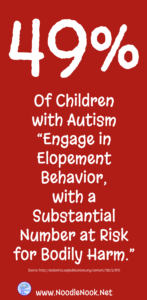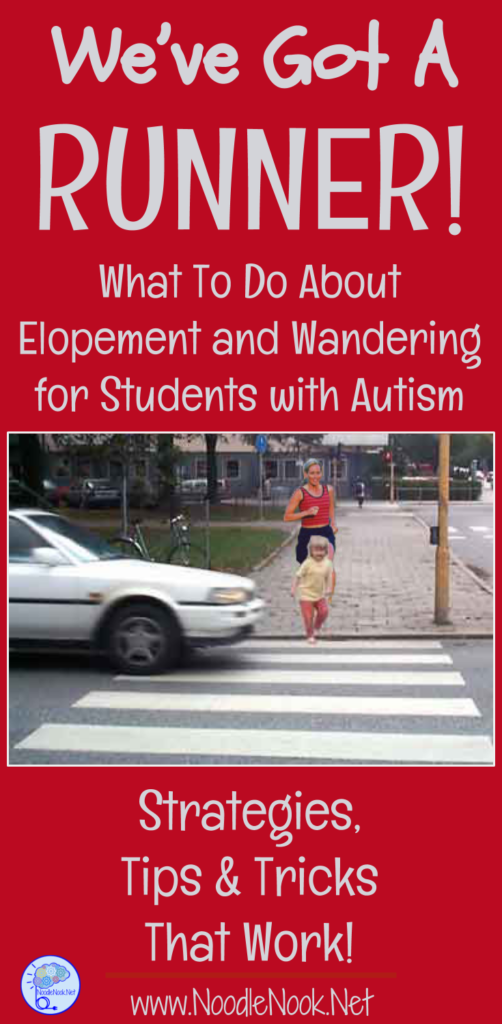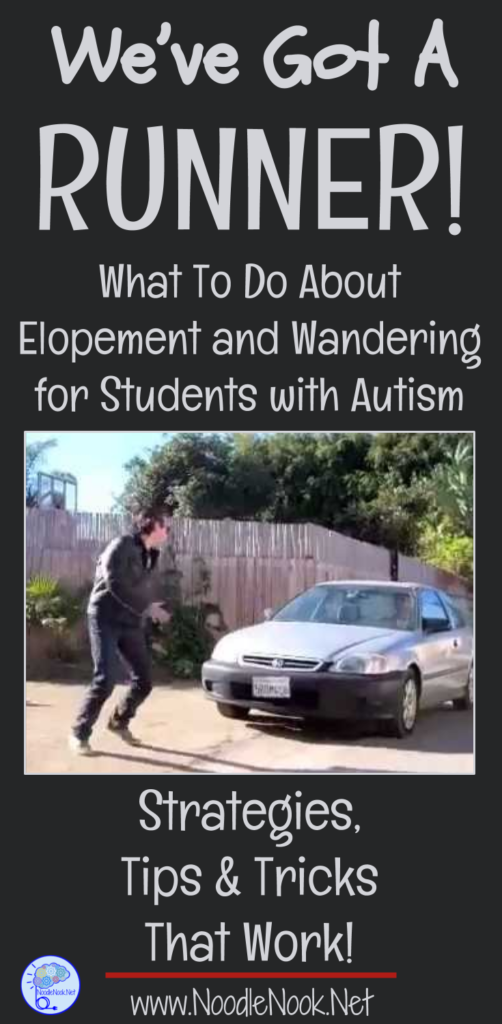Elopement and Autism
When I used to hear the word ‘Elopement’ I thought of two lovers running off to get hitched… but having been in Autism Units and LIFE Skills classrooms for so long ‘Elopement’ means something different. It means something that’s downright scary.
And it is downright scary when you look up and realize one of your students has wandered away or “eloped” the sense of panic that engulfs you is petrifying. Just downright scary.
It is also exhausting when you have to constantly stand in front of a door or always block a student from running (like out the door and into traffic). Just downright exhausting.
So what do you do? How do you get some control back when studies suggest nearly half of student with Autism wander or elope? Well, here are a few helpful tips and strategies…
Wandering and Elopement
With such a high incidence of wandering, and sometimes that is into water or into traffic, it becomes a major safety concern when students elope. So, as a teacher, what do you do? How can you stop it from happening?
First, why are students eloping?
When it comes to specific reasons, Autism Speaks did a survey and they found it is often because a child:
- Enjoys exploring
- Wants to go to a favorite place
- Wants to escape from a situation or environment
- Sensory reasons
When you read through this list, you can see a pattern. We cover this a lot in our post about the Function of Behavior, but almost all behavior is because someone wants to get something, wants to get away from something, or for sensory reasons.
It is no different in the classroom… if a student is running from your classroom or from you it is likely to get something, to get away from something, or for sensory reasons. There are some clear plans you need to put in place using an FBA and BIP, but it is also important to think about some meaningful ways to deal with the behavior in your plan.
Stopping Elopement with Prevention
Anything you can do to stop wandering and elopement BEFORE a student has a chance to leave is the best plan… but it doesn’t always work out that way. Regardless, it is important to put these strategies into place to get ahead of the behavior.
1. Physical Barriers
I am sure when you got a job teaching, you didn’t realize you were signing up to be a fancy door lock, spending your days preventing a door from opening. There is a better way. When you are thinking about the physical arrangement of your classroom, how can you make natural barriers to the door? Bookcases, desks, tables can all make it harder to run… and that gives you the extra split-second you need to stop a student before they head out.
This is important for a couple of reasons… if you are constantly standing in front of the door without making an attempt to change a student’s behavior eventually they see you as the door. That means when you are not there, right in front of the door, it is an open invitation to get up and go. Essentially you become the trigger to the behavior you are trying to stop.
The second reason this is important is because you have a million other things you need to do with all your students that cannot possibly allow you to be a door stop. That is the real reason you’re there, right? So let’s focus on using Physical Barriers to support us so we can support students. If you feel like you really struggle with setting up your Autism Classroom or Self-Contained class, you must get the ULTIMATE Guide & Checklist to Setup a Self-Contained Classroom or Autism Unit. What a lifesaver!
[dt_gap height=”10″ /]
2. Teaching Replacement Behavior
Running and wandering serves a purpose. The student is trying to get something, get away from something, or change the sensory input they’re getting. The reason they run is because they don’t have a better set of coping mechanisms to deal with their desire to change the current situation. That’s what we have to teach.
So how do we do that?
Some great tools to use as a means to teach target behavior to students with Autism are social stories and using behavior tools like token economies. With a social story we are outlining the appropriate way a student can access the things they want and the places they want to go. By repeatedly reviewing the procedures to do those two things, we can equip a student with the appropriate behavior as opposed to the running or wandering we are trying to eliminate.
Using token economies, break cards or first-then charts also make a huge difference. If a student clearly understands the expectation in the classroom and that they are working towards the things they want, you can start to eliminate running and wandering. A student will start to learn this way new and effective way to get what they want. Are you looking for more information on replacement behavior? Read more here: Autism Behavior Management.
[dt_gap height=”10″ /]
3. Giving Voice
I had a student with Autism who was also Echolalic and had a hard time communicating with others. After years of working with him without a problem (as in he went to lunch with minimal supervision, used the public bathroom unsupervised, and was able to move between classes independently) he started to wander off. My team started finding him all over campus and we couldn’t figure out what was triggering the behavior.
I was on a mission to determine what had changed and find out the function of this new behavior. One day on our way to the cafeteria I saw him start to wander off and I followed him. He went to a classroom on the opposite side of the building far away from our normal area… And then I found the function of his behavior. It was a very cute girl with bright eyes and a kind smile. She saw him, said hello, and walked on by. Bingo.
I stalked this girl down later and she let me know that my sudden eloper was appearing outside most of her classes throughout the day. He was wandering to see her. Unfortunately he struggled so much with communication that he really wasn’t able to engage with her in any other way. We had to work on giving him a voice so he could interact with her the way he really wanted to without displaying inappropriate behavior, like stalking.
Giving a student a voice can go beyond providing someone with the opportunity to communicate. Giving a student a voice can also include providing a way to share their name or contact information in case of an emergency. You can do that with an emergency contact card or social narrative of what to say to people we encounter when we are lost. I am a true believer in Core Vocabulary, and you can read more about that here: Getting Started with Core Vocabulary.
[dt_gap height=”10″ /]
4. Teaching ‘Help’ and ‘Danger’
Although this is another communication strategy, it warrants its own header so the strategy doesn’t get overlooked.
It is important to teach the word ‘help’ to students who are minimally verbal and also teach the idea of danger.
When students wanders out into moving traffic or in and around standing water it can be very dangerous. Understanding that danger and learning to avoid it can help a student be less vulnerable when they do elope and, let’s face it, you won’t be able to stop a student from eloping 100% of the time.
Some of our older students in middle and high school look quite ‘regular’ and also because of their size can seem dangerous to those who don’t know them. Often they do not respond to questions and interactions with others in a socially appropriate manner. Being able to ask for help goes a long way to disarm others and get them to offer aid instead of being combative. Sometimes that is especially important in keeping our students safe. We have help signs and other visual tools in the NoodleNook Behavior Toolkit, so check it out.
[dt_gap height=”10″ /]
5. Sensory Stimulation
Sometimes the reason for running has nothing to do with getting or getting away from something- it is sensory. The function of the running is because running feels great. I personally am not a runner. To me running is a fate worse than death. My sister loves to run though. She tells me running is like air to her. I guess it’s the same way I feel about Coca-Cola… it is my bliss.
Anyway, a student can just love the sensation of running. In this case, you have to build in a safe place and an appropriate time to let a student run. You also need to outline how a student earns running, how long it lasts, and how many times a day they can do it. When it comes to sensory motivation, ignoring the problem will not make it stop… Once I get the idea of a Coke in my head, you better believe I’m gonna get it. Once a student decides they love to run, you gotta to believe they’ll get it some how- so be sure you can control the situation? Want to read more about the function of behavior to see if it is sensory and maybe why they are running in the first place? Check out our post here: What the F (That’s Function)!
[dt_gap height=”10″ /]
6. GPS Tracking
About 6 months ago, I was called out in the middle of a Saturday to help search for a student who had wandered out of their house and was missing since early that morning. It was terrifying to be out looking for someone’s baby out lost in the world. I live in a major city and with so many hours having passed since he went missing, anything could have happened.
Just after 4 that afternoon, nearly 9 hours after his parents noticed he was missing, we found him wandering in the middle of the highway almost 6 miles form his house. 6 miles! And with cars blowing past him at highway speeds. He was in the median, which means he crossed a highway. Thankfully someone pulled over, called the police, and was able to help him get home.
The thought of losing a child for that long was horrible for me- just a year before we’d had a student in a neighboring district run away from their group home, get hit by a pickup truck, and die. I was horrified and I can only imagine what the parents were feeling. I never, ever want a parent, teacher, or community have to experience that. So, GPS tracking is an amazing way to use technology to ensure you can always find your child.
Technology is that missing piece, and modern technology lets parents have that lifeline to always know where their child is. If you have a student who is prone to wandering, send their parents here so they can hear my story and find out more about some options. If you are parent, I suggest you check out Angel Sense as an option or call in to your cell phone provider to see what services they provide. Believe me, you never want to risk the safety of your child if there is a better option.
Stopping Elopement in Your Autism Classroom
So, just to recap, these strategies will make a huge difference if you are working with a runner or eloper:
- Establish Physical Barriers
- Teach Replacement Behavior with Social Stories or Token Economies
- Give the Student Voice with Communication Systems or an Emergency Card
- Teach ‘Help’ and ‘Danger’
- Support Sensory Stimulation by Offering the Chance to Run
- GPS Tracking because as a parent, technology can help










What is youth skills programming elopement, I need to undersatand or what is elopement interms of skills programming for the youths.
Thanks
Ambayo Michael
Comments are closed.